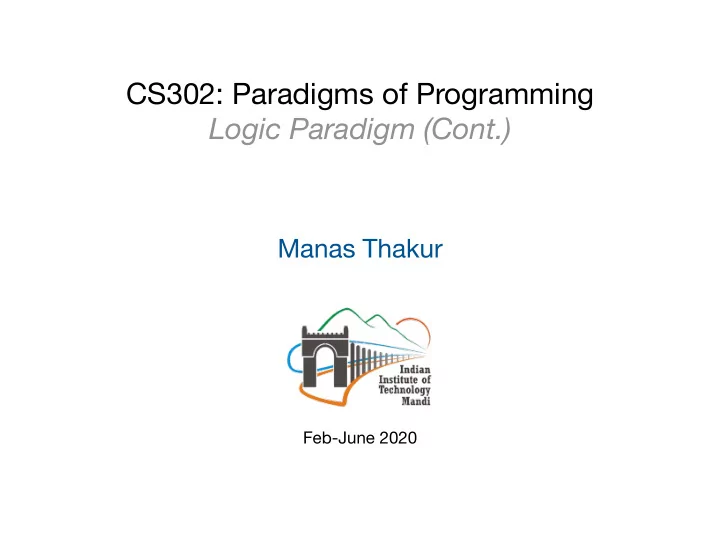

CS302: Paradigms of Programming Logic Paradigm (Cont.) Manas Thakur Feb-June 2020
Recall the problem that we had ended with • Ine ffi ciency in mutually exclusive cases: max(X, Y, Y) :- X =< Y. max(X, Y, X) :- X > Y. • Unexpected semantics in some others: factorial(N, 1) :- N = 0. factorial(N, Result) :- M is N - 1, factorial(M, SubRes), Result is N * SubRes. • What we want: A way to avoid further exploration. 2
Cuts • Interrupt execution if a subgoal is satisfied. • Improved max program: max(X, Y, Y) :- X =< Y, !. max(X, Y, X) :- X > Y. • How to correct the problem with removing N > 0 then? factorial(N, 1) :- N = 0. factorial(N, Result) :- N > 0, M is N - 1, factorial(M, SubRes), Result is N * SubRes. • Logic is independent of order; cuts make Prolog programs impure but e ffi cient. 3
Green cuts and Red cuts • Green cuts: Do not change program semantics. max(X, Y, Y) :- X =< Y, !. max(X, Y, X) :- X > Y. • Main purpose: E ffi ciency. • Red cuts: May change program semantics for certain inputs. factorial(N, 1) :- N = 0, !. factorial(N, Result) :- M is N - 1, factorial(M, SubRes), Result is N * SubRes. • What do we actually “cut”? 4
Negation factorial(N, 1) :- N = 0, !. factorial(N, Result) :- M is N - 1, factorial(M, SubRes), Result is N * SubRes. • Yet another way: factorial(N, 1) :- N = 0. factorial(N, Result) :- not(N = 0), M is N - 1, factorial(M, SubRes), Result is N * SubRes. • Though using negations might look easier than cuts, there is a big catch with negations in Prolog! 5
Negation as failure • Try this: bachelor_student(X) :- not(married(X)), student(X). student(joe). married(john). ?- bachelor_student(john). ?- bachelor_student(joe). • What should be the outcome of this? ?- bachelor_student(X). • Insight: Negation is actually implemented as follows: not(Goal) :- call(Goal), !, fail. not(Goal). • CQ: How can you correct this to be logically consistent? 6
Puzzles in Prolog 7
Who lives where • Ananya, Kriti, Manvi, Navya and Priya live in a five-room corridor in the Gauri Kund hostel, starting from 1 to 5. • Ananya doesn’t live in the fifth room and Kriti doesn’t live in the first. • Manvi doesn’t live in the first or the last rooms, and she is not in a room adjacent to Priya or Kriti. • Navy lives in some room later than Kriti. • Who lives in which room? 8
Who lives where (Cont.) • Say the solution should look like this: • [room(_,5), room(_,4), room(_,3), room(_,2), room(_,1)] • The five variables to be assigned rooms are: A , K , M , N and P . • Say the structure rooms(Rooms) contains the solution list. • The first constraint can be encoded as: • member(room(ananya, A), Rooms), A \= 5. • We can similarly add the other constraints to give the complete program . 9
Who lives where (Cont.) rooms([room(_,5),room(_,4),room(_,3),room(_,2),room(_,1)]). hostel(Rooms) :- rooms(Rooms), member(room(ananya, A), Rooms), A \= 5, member(room(kriti, K), Rooms), K \= 1, member(room(manvi, M), Rooms), M \= 1, M \= 5, member(room(priya, P), Rooms), not(adjacent(M, P)), not(adjacent(M, K)), member(room(navya, N), Rooms), N > K, print_rooms(Rooms). where adjacent and print_rooms are defined as follows: adjacent(X, Y) :- X =:= Y+1. adjacent(X, Y) :- X =:= Y-1. print_rooms([A | B]) :- write(A), nl, print_rooms(B). print_rooms([]). Solution: ?- hostel(X). 10
Natural Language Processing in Prolog 11
NLP in Prolog • Natural languages (say English ) can be defined using Backus Naur Form (BNF) — a grammar notation. • A Prolog program can model a BNF grammar. • A Prolog list can model a sentence. • Example: [this, teacher, rocks] • Thus, running the program can parse an English sentence! 12
Parse Trees • Consider the following grammar: s → np vp np → det n vp → tv np → iv det → this n → teacher → student iv → rocks tv → dreams this teacher rocks Here, s , np , vp , det , n , iv , and tv denote “sentence,” “noun phrase,” “verb phrase,” “determiner,” “noun,” “intransitive verb,” and “transitive verb”, respectively. 13
Naive Prolog Encoding s(X, Y) :- np(X, U), vp(U, Y). np(X, Y) :- det(X, U), n(U, Y). vp(X, Y) :- iv(X, Y). vp(X, Y) :- tv(X, U), np(U, Y). det([this | Y], Y). n([teacher | Y], Y). n([student | Y], Y). iv([rocks | Y], Y). tv([dreams | Y], Y). • First rule: • List x is a sentence leaving tail Y if X is a noun phrase leaving tail U and U is a verb phrase leaving tail Y. 14
Definitive Clause Grammars (DCGs) s(X, Y) :- np(X, U), vp(U, Y). s --> np, vp. s(X, Y) :- np(X, U), vp(U, Y). s --> np, vp. np(X, Y) :- det(X, U), n(U, Y). np --> det, n. vp(X, Y) :- iv(X, Y). vp --> iv. vp(X, Y) :- tv(X, U), np(U, Y). vp --> tv, np. det([this | Y], Y). det --> [this]. n([teacher | Y], Y). n --> [teacher]. n([student | Y], Y). n --> [student]. iv([rocks | Y], Y). iv --> [rocks]. tv([dreams | Y], Y). tv --> [dreams]. 15
Recommend
More recommend